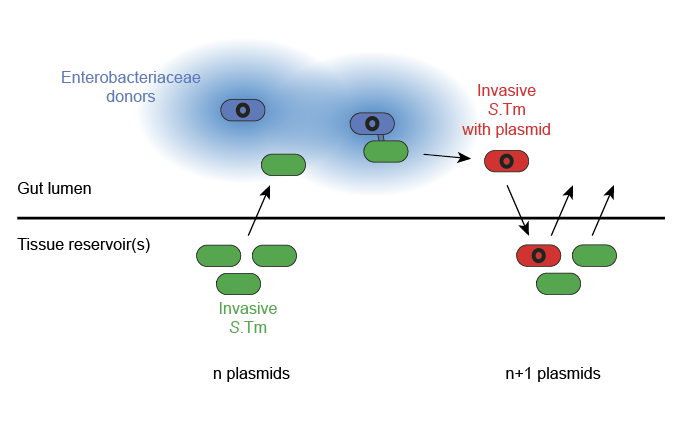Invasive properties of bacterial pathogens can boost plasmid spread in the gut
Plasmids can encode antibiotic resistance genes. In a recent paper in eLife, Erik Bakkeren, Wolf-Dietrich Hardt, and colleagues (IMB) show that the gut pathogen Salmonella Typhimurium can collect plasmids from other gut bacteria and store them in tissues, creating a plasmid “record” within hosts.

Antibiotic resistance is a threat. Through conjugation, resistance plasmids can spread rapidly. Salmonella enterica serovar Typhimurium (S.Tm) is a gut pathogen that can invade and hide within gut tissues for long times. Previous work established that these "persisters" can store resistance plasmids and promote their spread. However, how such tissue-lodged reservoirs of plasmid-bearing cells are formed had remained unclear. Bakkeren et al. asked if tissue invasion by such pathogens followed by re-seeding of the gut could "store" ever more resistance plasmids in the host tissues, and thereby promote plasmid spread. Using mouse models for S.Tm infection, the team showed that S.Tm cells can re-seed the gut lumen from tissue reservoirs, and acquire plasmids from other gut bacteria. In the case of beta-lactam antibiotic resistances, the donor bacteria degraded the antibiotic locally and thereby further promoted recipient survival and plasmid transfer. Afterwards, plasmid-loaded S.Tm cells re-entered host tissues introducing the new plasmid into the tissue-lodged reservoir. A mathematical model identified re-seeding into the gut lumen as rate-limiting for plasmid transfer in these experiments. Overall, this proof-of-principle study indicates that gut-luminal antibiotic degradation and pathogen shuttling between the gut lumen and tissue reservoirs can promote the accumulation and spread of plasmids within a host over time.
Link to the paper in external page eLife